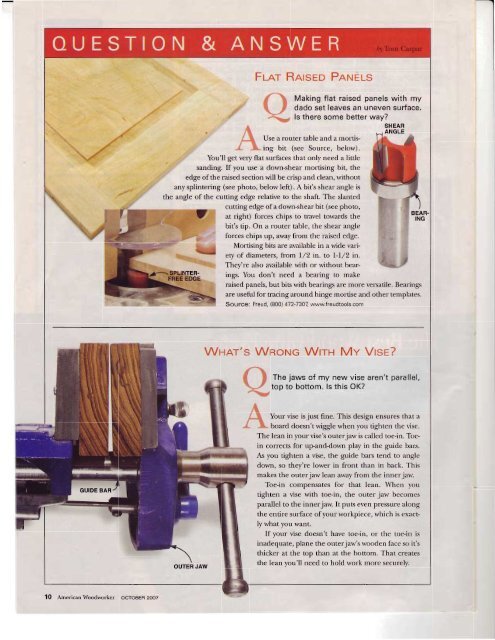AW #131.pdf - Karatunov.net
AW #131.pdf - Karatunov.net
AW #131.pdf - Karatunov.net
Create successful ePaper yourself
Turn your PDF publications into a flip-book with our unique Google optimized e-Paper software.
t,,,i'"''<br />
h-:--rc<br />
''"il*r,<br />
10 AmericanWoodworker ocroBER2ooT<br />
.<br />
F n Rarsro Pnrurls<br />
Use a router table and a mortis-<br />
ing bit (see Source, below).<br />
You'll get very flat surfaces that only need a little<br />
sanding. If you use a down-shear mortising bit, the<br />
edge of the raised section will be crisp and clean, without<br />
any splintering (see photo, below left). A bit's shear angle is<br />
the angle of the cutting edge relative ro the shaft. The slanted<br />
_ry<br />
%q"qrwror<br />
cutting edge of a down-shear bit (see photo,<br />
at right) forces chips to travel towards the<br />
bit's tip. On a router table, the shear angle<br />
forces chips up, away from the raised edge.<br />
Mortising bits are alailable in a wide vari-<br />
ety of diameters, from l/2 in. to 7-l/2 in.<br />
They're also arailable with or without bear-<br />
ings. You don't need a bearing to make<br />
Making flat raised panels with my<br />
dado set leaves an uneven surface.<br />
ls there some better way?<br />
raised panels, but bis with bearings are more versatile. Bearings<br />
are useful for tracing around hinge mortise and other templates.<br />
Source : Freud, (800) 47 2-7 307, www.f reudtools.com<br />
WuRr's Wnoruc WlrH Mv Vrsr?<br />
t I The jaws of my new vise aren't parallel,<br />
V top to bottom. ls this OK?<br />
^v<br />
l<br />
/-f Your vise is.just fine. This design ensures that a<br />
J- I board doesn't wiggle when you righten the vise.<br />
The lean in your vise's outerjaw is called toe-in. Toe-<br />
in corrects for upanddown play in the guide bars.<br />
As you tighten a vise, the guide bars tend to angle<br />
down, so they're lower in front than in back. This<br />
makes the outerjaw lean away from the innerjaw.<br />
Toe-in compensates for that lean. When you<br />
tighten a vise with toe-in, the outer jaw becomes<br />
parallel to the innerjaw. It puts even pressure along<br />
the entire surface of your workpiece, which is exact-<br />
ly what you want.<br />
If your vise doesn't have toe-in, or the toe-in is<br />
inadequate, plane the outerjaw's wooden face so it's<br />
thicker at the top than at the bottom. That creates<br />
the lean you'll need to hold work more securely.










